RDP 2023-08: The Evolution of Consumer Payments in Australia: Results from the 2022 Consumer Payments Survey 5. Card Payments
November 2023
- Download the Paper 2.30MB
5.1 Card use
The results of the 2022 CPS show that Australians continued to shift to using cards for their day-to-day transactions. Since the CPS was first conducted in 2007, cards have been replacing cash and have become the dominant payment method.[8] In 2022, three-quarters of payments were made with cards – three times the share in 2007 (Table 1). In value terms, payments made using cards accounted for two-thirds of the total value of payments in 2022, an increase of 24 percentage points from 2007. The increase in card usage mirrors the decline in cash usage.
The rising popularity of cards reflects both changing consumer preferences and widespread acceptance of electronic payments by merchants. Australian consumers have increasingly preferred to use cards to make payments as new technology and innovation in the payments space have made cards more convenient and easier to use. Cards have become very popular for Australian consumers: 99 per cent of respondents in the 2022 CPS reported that they held at least one debit and/or credit card and just under half indicated that they held both types of cards. Merchant acceptance is also very high; a Reserve Bank survey in 2022 found that 97 per cent of retail merchants accepted card payments.[9] The high rate of card acceptance by merchants partly reflects the ubiquity of card ownership and use among consumers, as well as reductions in merchant acceptance fees over time and Reserve Bank reforms making it possible for merchants to surcharge for card payments (Gill, Holland and Wiley 2022). Wider card acceptance in recent years also appears to have been facilitated by new payments providers catering to small and micro merchants, as well as more convenient technology such as simpler point-of-sale terminals and mobile payment terminals.
Cards are now used widely across demographic groups, though some important differences remain. Younger people use cards most intensively, with consumers aged 18–29 years using cards for around 85 per cent of their payments (Figure 17, left panel). Consumers aged 65 and above were historically high cash users; however, they now use cards for nearly two-thirds of their payments. Compared with 2019, the share of transactions made using cards rose most strongly for consumers aged 40 years and older, with the rise mainly driven by a strong increase in card payments for low-value transactions. The increase in card use was more modest for consumers under 40, as for this group the share of low-value payments made using cards had already reached a high level in 2019.
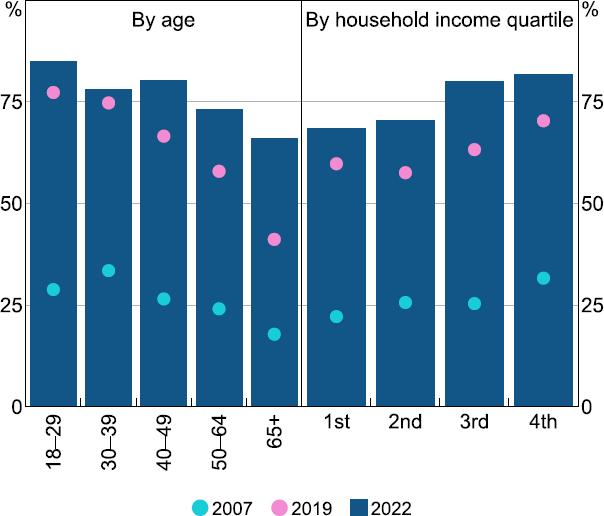
Note: Because of the overlap between age and income groups, the data for income quartiles are adjusted for respondent's age.
Source: RBA calculations, based on data from Ipsos and Roy Morgan Research.
The rise in the share of card payments between 2019 and 2022 was evident across all income groups (Figure 17, right panel). The growth in card usage was strongest in the middle-income groups (i.e. the second and third income quartiles). High-income households had the greatest propensity to use cards, with cards accounting for 82 per cent of their payments, compared with 69 per cent for those in the lowest income quartile.
In 2022, cards were used more frequently than in 2019 for payments of nearly all sizes. The increase in relative card use was most pronounced for lower-value transactions (Table 3). The one category where the share of card payments declined was for payments over $500, as more of these large transactions were made using other payment methods such as bank transfers and PayPal.
| 2007 | 2010 | 2013 | 2016 | 2019 | 2022 | |
|---|---|---|---|---|---|---|
| Payment value ($) | ||||||
| 1–10 | 4 | 7 | 18 | 32 | 52 | 72 |
| 11–20 | 21 | 26 | 39 | 52 | 64 | 78 |
| 21–50 | 40 | 43 | 54 | 61 | 70 | 79 |
| 51–100 | 54 | 59 | 63 | 65 | 74 | 79 |
| 101–500 | 51 | 53 | 59 | 62 | 64 | 74 |
| 501+ | 49 | 41 | 51 | 50 | 52 | 49 |
| Broad merchant categories | ||||||
| Supermarket | 39 | 46 | 59 | 63 | 74 | 84 |
| Food retail | 10 | 14 | 27 | 43 | 62 | 81 |
| Goods retail | 35 | 40 | 48 | 55 | 67 | 76 |
| Transport(a) | 15 | 17 | 34 | 49 | 71 | 87 |
| Petrol/service station | 51 | 54 | 66 | 67 | 76 | 84 |
| Leisure/entertainment | 12 | 19 | 36 | 37 | 50 | 64 |
| Holiday | 65 | 69 | 74 | 79 | 81 | 78 |
| Bills(b) | 28 | 22 | 33 | 35 | 29 | 33 |
| Services | 27 | 33 | 38 | 46 | 48 | 62 |
| Other | 25 | 30 | 41 | 47 | 56 | 66 |
|
Notes: Excludes payments over $9 999, transfers (payments to family and friends) and automatic payments.
Source: RBA calculations, based on data from Colmar Brunton, Ipsos and Roy Morgan Research. |
||||||
The 2022 CPS showed that cards were the predominant payment method at almost all types of businesses (Table 3). Cards accounted for more than 80 per cent of transactions at supermarkets, food retailers, transport businesses, and petrol and service stations. The high share of card payments at supermarkets may reflect the convenience of using a card at these businesses – for instance, supermarkets were among the first businesses to introduce contactless card terminals in Australia and have recently introduced self-service checkouts that do not accept cash. In addition, many supermarkets do not surcharge card payments, making this payment method a more attractive choice than at businesses that do surcharge. Card payments are used least for household bills, with consumers tending to use lower-cost payment methods such as bank transfers and BPAY for these payments.
5.2 Credit and debit cards
The increase in card usage over the last decade has reflected greater use of both debit and credit cards. Since 2007, consumers have consistently increased their usage of debit cards. Payments made using debit cards accounted for half of all payments in 2022 – more than three times their share in 2007. The increased use was initially supported by the introduction of debit cards that provided much of the same payment functionality as credit cards, such as the ability to make online payments. More recently, in response to the pandemic, banks sent debit cards to Australian account holders who did not have a linked debit card (e.g. passbook holders), making debit cards even more widely available. The stronger uptake of debit cards partly reflects Australian consumers preferring to use their own funds from their deposit account, rather than borrowed funds from a credit card. Particularly over the last few years, younger consumers have consistently shown a greater preference for using their own funds. In addition, the decline in the generosity of credit card reward programs and generally higher surcharges for credit cards than debit cards have meant that consumers have opted to use debit cards more often as they switch away from cash payments.[10]
The usage of credit and debit cards varies by household income. Lower-income households use debit cards and cash more frequently than higher-income households. In 2022, consumers in the lowest income quartile made 55 per cent of their transactions with debit cards, compared with 45 per cent for those in the highest income quartile (Figure 18, left panel). By contrast, consumers in the highest income quartile used credit cards for around one-third of their total payments, which is three times the share for consumers in the lowest income quartile. This may reflect higher-income households being more likely to meet the lending standards for a credit card, as well as debit cards and cash being used as budgeting tools for lower-income households.
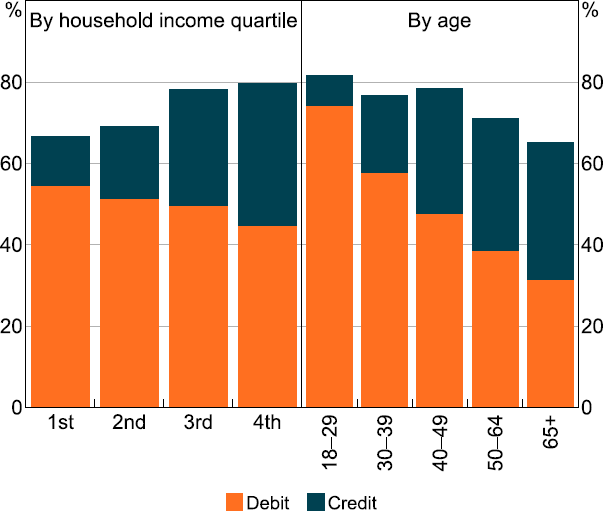
Note: Because of the overlap between age and income groups, the data for income quartiles are adjusted for respondent's age.
Source: RBA calculations, based on data from Ipsos.
The use of credit and debit cards diverges across age groups. Younger consumers are more likely to use debit cards more intensively whereas older consumers tend to use credit cards and cash more frequently to make payments. In 2022, consumers aged 18–29 made three-quarters of their total transactions with debit cards – more than double the share for consumers over 65 (Figure 18, right panel). While consumers of all ages used debit cards more frequently than they did in the previous survey, the recent increase has been most pronounced among consumers aged under 30 and over 65. The share of payments made using debit cards by these groups increased by around 10 percentage points between the 2019 and 2022 surveys. For consumers aged over 40 the share of payments using credit cards increased significantly. However, consumers aged under 40 used credit cards less frequently than they did in 2019 (Figure 19).
Consumers aged under 30 made more than three-quarters of their payments using debit cards (Figure 20). While this age group are less likely to hold a credit card than those in other age cohorts, younger people that own a credit card still made over half of their payments using a debit card.[11] In contrast, consumers aged over 50 made around one-third of their payments with a debit card, with a less pronounced difference in debit card use between those who held a credit card and those who did not.
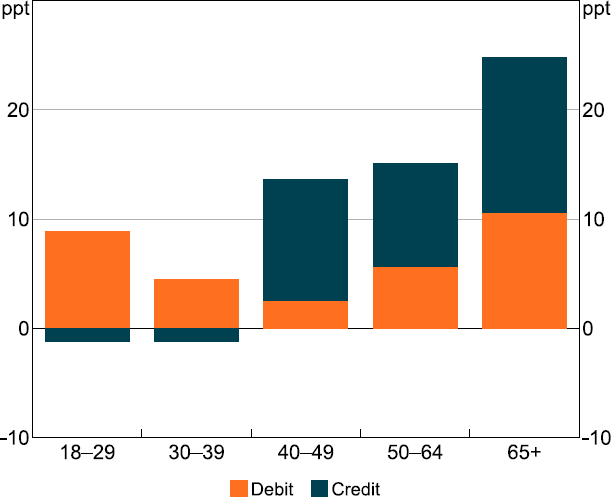
Source: RBA calculations, based on data from Ipsos and Roy Morgan Research.
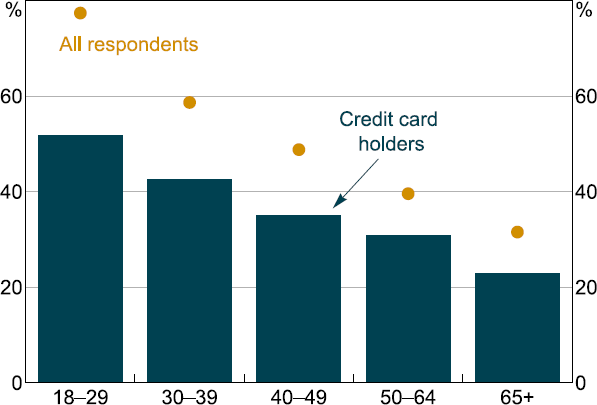
Source: RBA calculations, based on data from Ipsos.
5.3 Contactless and mobile card payments
The way Australians undertake their payments has changed significantly over the past decade. Most in-person card payments are now made using contactless functionality, including through the use of mobile devices.[12] In 2022, these payments made up 95 per cent of in-person card payments, an increase of 10 percentage points from 2019 (Figure 21). By contrast, when the CPS was first conducted in 2007, almost all in-person card transactions were made by swiping or inserting the card into a terminal at the store checkout (and providing a personal identification number (PIN) or signature for verification). In 2022, these payments made up only 5 per cent of in-person card payments.
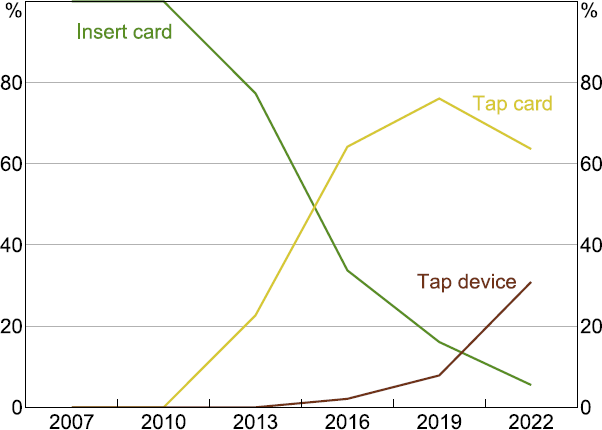
Source: RBA calculations, based on data from Colmar Brunton, Ipsos and Roy Morgan Research.
Most contactless payments were initiated by tapping a physical card on a point-of-sale terminal. But the use of mobile devices to make contactless payments – by tapping a smartphone or other payment-enabled mobile device, such as a watch, ring or other ‘wearable’ device – increased sharply from a low base. Contactless mobile payments accounted for nearly one-third of in-person card payments in 2022, up from just 8 per cent in 2019 (Figure 21). The increased adoption of contactless mobile payments has been supported by this payment option becoming more widely available to consumers, due to the increased availability of devices equipped with mobile payment functionality combined with most card issuers supporting the storage of their cards in mobile wallets (such as those provided by Apple, Google and Samsung). Adoption has also been supported by consumers' greater awareness of this payment method, as well as widespread merchant acceptance of contactless card payments more generally.
The pandemic also contributed to greater adoption of contactless payments by changing the behaviour of consumers, merchants and payment providers. Consumers shifted towards electronic payment methods because of hygiene concerns with handling cash and an increase in online payments due to lockdowns and social distancing. During the pandemic, the payments industry also facilitated a move to contactless transactions by increasing the transaction limit below which a PIN was not required for a contactless card payment from $100 to $200.[13] Between 2019 and 2022, the share of contactless payments increased by 35 percentage points for payments over $100 – a stronger rise than for lower-value transactions (Figure 22). Consumers mainly switched from inserting a card to using contactless payments for these larger payments. Nonetheless, the use of contactless functionality by consumers also increased significantly for lower-value transactions. For example, the share of in-person payments of $10 or less made by tapping a card or a mobile device increased by 24 percentage points between 2019 and 2022, to 48 per cent. For payments of this size, consumers generally substituted from cash to contactless mobile device payments.
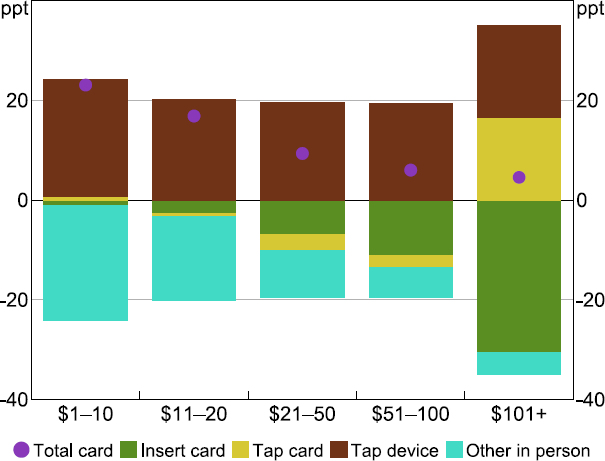
Source: RBA calculations, based on data from Ipsos and Roy Morgan Research.
The use of mobile wallets increased for Australians of all ages between 2019 and 2022. In 2022, more than one-third of consumers used a mobile device to make a contactless payment in the diary week – an increase of 25 percentage points from 2019. The increase in adoption was particularly pronounced for younger consumers. Mobile payments were used by nearly two-thirds of Australians aged between 18 and 29 in 2022, up from less than 20 per cent in 2019. For consumers aged 65 and over, only 9 per cent made a mobile payment during the diary week, although this was triple the share in 2019 (Figure 23, top panel). In 2022, mobile devices were used intensively by those consumers who had adopted mobile payments, and this trend was evident across all age groups – mobile device payments accounted for more than half of such consumers' in-person payments. Users aged over 65 recorded a particularly strong increase in their intensity of mobile payment usage between 2019 and 2022 (Figure 23, bottom panel).
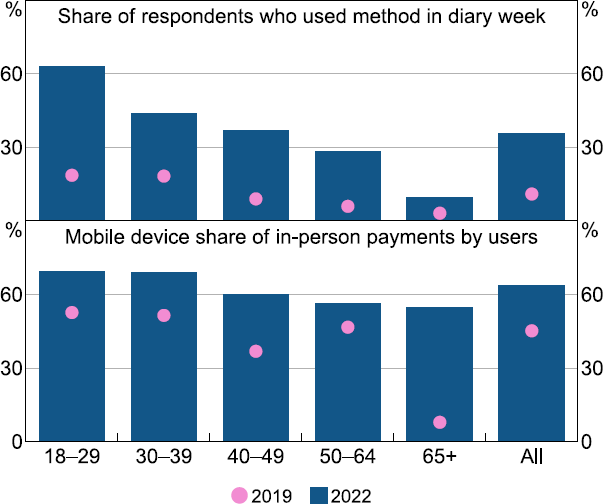
Note: Only includes respondents that made mobile device payments at least once in the diary week.
Source: RBA calculations, based on data from Ipsos and Roy Morgan Research.
In addition to the diary data, all respondents were asked if they stored each of their payment cards in a mobile wallet (such as Apple Wallet, Google Wallet, Samsung Wallet etc). Around half of respondents stated that they had a card stored in a mobile wallet in 2022, with younger people reporting the highest shares (Figure 24, top panel). Mobile wallets have become more popular for consumers of all age groups since 2019 (Figure 24, bottom panel). Having a single card stored in a mobile wallet is more common than having multiple cards stored. Nearly 90 per cent of CPS respondents indicated that they were at least aware of the ability to make contactless payments via a payments-enabled mobile device.
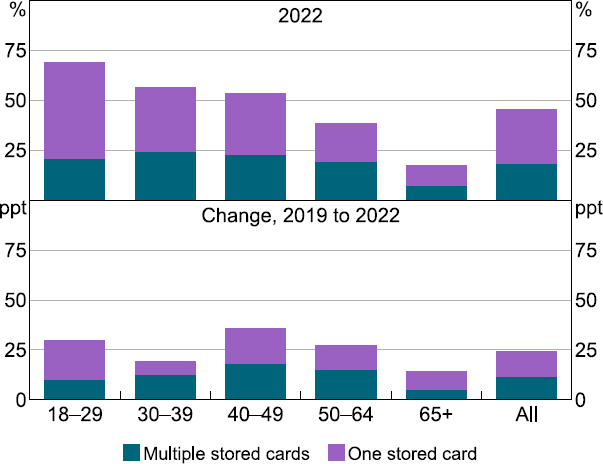
Source: RBA calculations, based on data from Ipsos and Roy Morgan Research.
Australia has adopted contactless payments earlier and reached near universal uptake before some other countries (Figure 25). Besides consumer demand for convenience, the rise of contactless payments in Australia has been strongly supported by the fast rollout of contactless-enabled cards and terminals by card schemes, card issuers and payment service providers. Early adoption by the hospitality industry and large merchants such as supermarkets and department stores also facilitated consumer uptake. As discussed earlier, the pandemic also spurred greater use of electronic payments, including contactless payments.
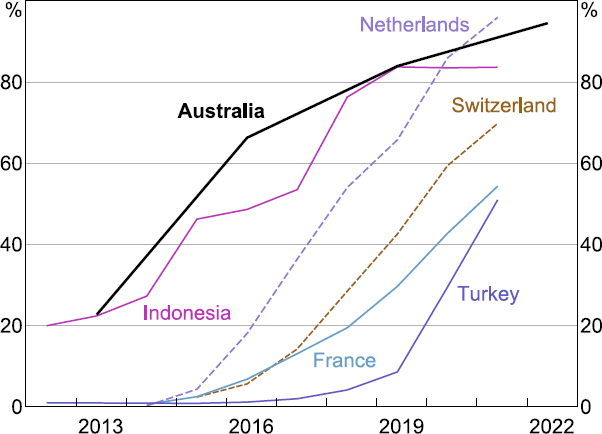
Note: Observations are not directly comparable due to differing survey methods and inclusions across economies.
Sources: BIS; RBA calculations based on data from Colmar Brunton, Ipsos and Roy Morgan Research.
5.4 Surcharging of card transactions
To recover the cost of accepting card payments, a merchant may apply an additional fee, or surcharge. The Reserve Bank first enacted rules in 2003 to require card schemes to remove their ‘no-surcharge’ rules, thereby freeing merchants to surcharge card payments. The Reserve Bank's rules are aimed at supporting the efficiency of the payments system, by ensuring that consumers are encouraged to use the lowest cost payment instrument. Changes to the Reserve Bank's surcharging rules were made following a review in 2015–2016, which reduced the allowed size of surcharges levied by merchants in some industries.
The survey showed that the frequency of surcharging increased from 2019 to 2022. CPS participants reported that a surcharge was paid on 7 per cent of card transactions in 2022 (Table 4), up from around 5 per cent of card transactions in 2019. When measured as a percentage of the transaction value, the median surcharge reported was 1.5 per cent, which was 50 basis points lower than three years earlier. In value terms, the median surcharge declined from 80¢ to 50¢.[14] The reduction in median surcharges is consistent with the increased use of cards for lower-value purchases between 2019 and 2022, as well as the decline in the average cost of card payments.
In past surveys, a number of factors were associated with whether a surcharge was paid by consumers, such as the type of card used and the environment in which the payment was made (e.g. online or in person). However, these factors appear to have diminished in importance in the latest survey. For instance, in the 2022 CPS surcharges were paid equally as often on credit card and debit card payments (Table 4); in previous years, credit card payments were surcharged more often. The increased prevalence of debit card payments, greater use of payment plans that charge merchants a single percentage rate for accepting all card types, and the emergence of payment providers that offer automatic surcharging may have all contributed to the convergence in surcharging frequency on credit and debit cards. Similarly, while online payments continued to be surcharged more frequently than in-person payments, the difference in frequency was narrower than in past surveys. Consumers who held a credit card that offered rewards points – which tend to be relatively expensive for merchants to accept – were more likely to have paid a card surcharge than those who owned a non-rewards credit card; however, once again the difference was smaller than in past surveys.
| 2019 | 2022 | |
|---|---|---|
| All card payments | 4.7 | 7.3 |
| Credit cards | 5.5 | 7.3 |
| Debit cards | 4.3 | 7.3 |
| Reward cardholder status | ||
| Owns a rewards card | 5.3 | 7.5 |
| Does not own a rewards card | 3.7 | 6.6 |
| By payment channel | ||
| In-person | 4.0 | 7.1 |
| Online | 9.2 | 8.5 |
|
Notes: Excludes payments over $9,999, transfers (payments to family and friends) and automatic payments. Numbers published in Caddy et al (2020) differ because of data cleaning approach. Source: RBA calculations, based on data from Ipsos and Roy Morgan Research. |
||
Respondents were also asked about their typical response when they discover that a merchant levies a surcharge on some payment methods. Around 45 per cent of consumers said they would choose a non-surcharged method when faced with a surcharge (Figure 26). This level indicates that there is some scope for merchants to encourage consumers to switch to a different, lower-cost payment method by applying a surcharge on certain payments. Nonetheless, in 2022 a greater share of respondents reported being likely to accept surcharges than in 2019. The increased acceptance of surcharges by consumers may reflect the fact that fewer consumers carried a non-surcharged payment method such as cash. Around 20 per cent of consumers would avoid shopping at a merchant that levies a surcharge. This possibility of losing customers helps explain why many merchants choose not to apply a surcharge on card payments.
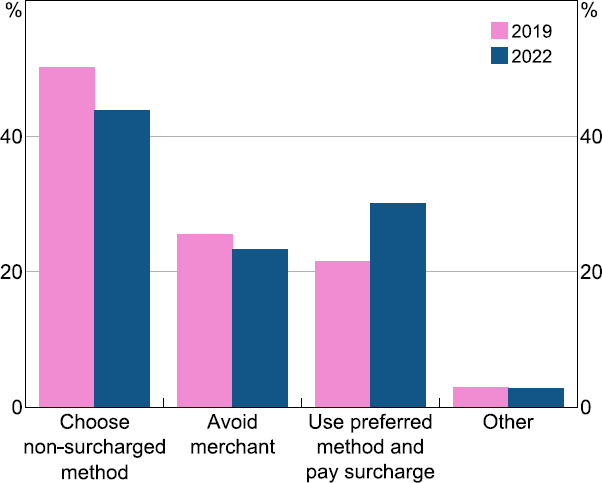
Source: RBA calculations, based on data from Ipsos and Roy Morgan Research.
5.5 Dual network debit cards
In the 2022 CPS the Reserve Bank included some new questions to gauge consumer awareness of dual network debit cards (DNDCs). These questions will help inform policy as the Reserve Bank seeks to increase competition and reduce costs in the debit card market.
DNDCs, also called ‘co-badged’ or ‘multi-network’ cards, have access to two debit payment networks on the one card. In Australia, DNDCs typically have access to the domestic debit network – eftpos – and one of the international debit networks such as Visa or Mastercard. In Australia, 85 per cent of debit cards are DNDCs, with the remainder being single network debit cards. DNDCs give consumers the ability to make transactions on either network where it is available. For instance, a consumer travelling overseas could use the international network on their card, while in Australia they could use either the eftpos network or the international network. The Reserve Bank supports the issuance of DNDCs to provide effective competition between networks, which can put downward pressure on fees for merchants and consumers.
There are three main ways the network on a DNDC can be chosen to make a payment. First, a default network can be set by the issuer of the card, and this might be influenced by rules set by the card schemes. For example, for contactless payments, DNDCs are currently set to default to the international network. Second, the merchant could have least-cost routing (LCR) enabled. This lets merchants choose to override the default network for contactless payments. Merchants may want to choose the network because one network on a DNDC could be cheaper for the merchant to accept than the other. Third, the consumer could choose the network, for example by inserting the card at a terminal and selecting from an on-screen option. Consumers may have a range of reasons for wanting to choose the network, including to avoid or reduce a surcharge (which can vary by network).
In recent years, the Reserve Bank has encouraged the rollout of LCR. This functionality gives merchants the ability to set up rules ahead of time to choose the lowest-cost payment network for a particular contactless or online payment made using a DNDC. LCR can lower merchants' payment costs and encourages competition in the debit card market. But it means that consumers may not know which network on their card will be used to make a payment. By gauging consumer awareness of DNDCs the Reserve Bank can understand more about the costs and benefits of providing consumer choice and the factors driving consumers' choices.
In the 2022 CPS, the Reserve Bank asked five questions about DNDCs: one in the pre-diary and four in the post-diary questionnaire. The original survey questions are more detailed than the paraphrased questions and responses used in the material below. The full questions did not assume much knowledge of the debit card market nor use the terminology ‘dual network debit card’, see Appendix A.3 for the full wording of questions.
The first question gauged consumers' knowledge of whether they had a DNDC. Before a consumer can choose the network on their DNDC they must first know they own a debit card with more than one network. This question was only given to the 93 per cent of consumers who owned a debit card. The first question was specifically worded to get consumers to answer using their existing knowledge, not to get them to check their cards or investigate further. Just over 40 per cent of consumers said they knew that they had a DNDC, just under 40 per cent were unsure, and the remainder said they did not have a DNDC (Figure 27).
The large share of consumers that were not sure that they had a DNDC highlights the lack of general consumer knowledge of DNDCs. This could partly reflect the rise of contactless payments, where DNDC payments are routed without consumers making an active choice, resulting in less consumer engagement with their options. Consumer awareness of the second network on DNDCs may also be inhibited by the front of the card typically just showing the international network's logo, with the eftpos logo displayed on the back of the card.
While just over 40 per cent of consumers said they knew that they had a DNDC, this could overstate consumer awareness for a few reasons. First, the question came after consumers were asked whether they had a debit or credit card and what specific cards they owned; some consumers may have inadvertently checked their cards when answering those questions. Second, while consumers were asked not to check their debit cards to see if they had a DNDC, some may have intentionally done so anyway. Third, respondents to the survey may be more engaged with payments than the average consumer, since they agreed to complete a payments survey. Working in the other direction, some consumers may have been confused by the terminology used in the survey and may have been aware of the type of debit card they owned.
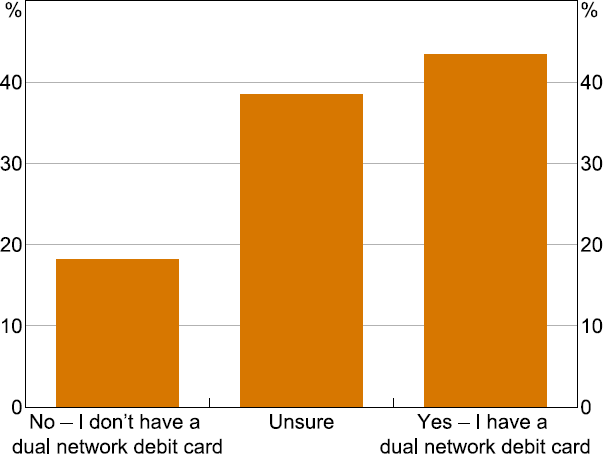
Note: Share of respondents with at least one debit card answering the question ‘Off the top of your head, do you know if you have a debit card that can process payments through more than one network?’.
Source: RBA calculations, based on data from Ipsos.
To assess the actual rate of DNDC ownership, in the post-diary questionnaire consumers were given specific instructions on how to check their cards. After being presented with these instructions, just under 90 per cent of consumers reported having a DNDC (Figure 28). This is close to the system-wide average of 85 per cent of Australian debit cards being dual network, and suggests that consumers were able to accurately determine if their cards were dual network. Comparing the results of the pre-diary with the post-diary questions shows that there were often significant differences in consumers' answers to the two questions. For instance, over three-quarters of those that initially said they did not have a DNDC, said after inspecting their cards that they did have a DNDC. In total, just over 55 per cent of consumers were either initially unsure or incorrect about whether they had a DNDC. This again highlights consumers' general lack of knowledge about DNDCs.
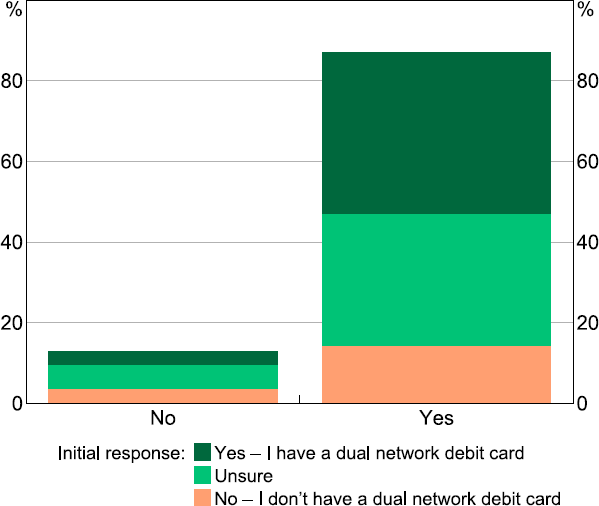
Note: Share of respondents with at least one debit card answering the question ‘Check your debit card(s), do you have a debit card that has both the logo of one of the international networks on the front and the eftpos logo on the back?’.
Source: RBA calculations, based on data from Ipsos.
To gauge consumers' desire to choose the network on their DNDC, they were then asked whether it mattered to them which network on their card processed their transactions. Most consumers reported that it did not matter to them which network on their card processed their transactions, with just under one-fifth of consumers reporting it did matter (Figure 29). The high share of consumers that said it did not matter to them may reflect an assessment that there are limited benefits to gain from choosing one network over another or a lack of awareness of the differences. In general, benefits or rewards for using a specific debit network are rare, although some merchants may charge a lower surcharge for some networks, and some networks may have stronger protections or better refund/chargeback processes.
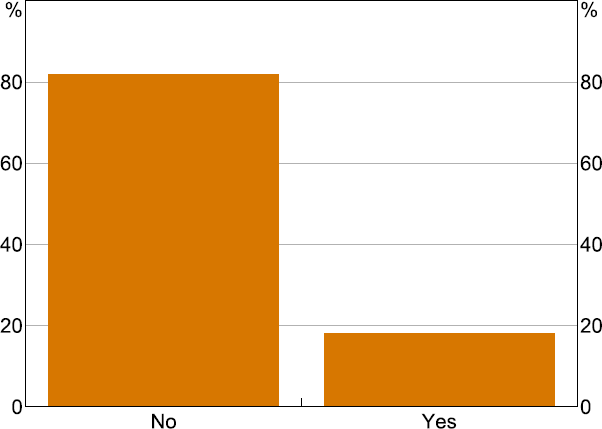
Note: Share of respondents with at least one dual network debit card answering the question ‘Thinking about your ATM/debit card(s) that has more than one network, does it matter to you which network on your card(s) processes your transactions?’.
Source: RBA calculations, based on data from Ipsos.
Consumers were then asked whether they favoured a particular network. Among the one-fifth of debit card owners that had a preference, broadly similar shares preferred eftpos, Visa and Mastercard (Table 5). While eftpos was the single most chosen network, consumers do not get to choose between all three networks at the same time; instead they choose between eftpos and Visa, or between eftpos and Mastercard. As a group, the international schemes were more favoured by consumers than eftpos.
Finally, to assess influences that would drive consumers to choose one network over another, they were asked to choose the factors that guided their choice of network. The main reasons stated for preferring one network over another were the perceived safety/security of a transaction, surcharges, merchant acceptance and speed of transaction (Table 5). Few consumers reported choosing debit networks based on reward points or additional warranties.
Overall, these results suggest that consumers have low awareness of DNDCs and showed that only a small share of consumers cared which network processed their debit transactions.
| All DNDC holders (%) |
DNDC holders that have a preferred network (%) |
|
|---|---|---|
| Does not matter which network processes transactions | 82 | na |
| Have a preferred network | 18 | 100 |
| eftpos | 7 | 39 |
| Visa | 5 | 30 |
| Mastercard | 5 | 27 |
| Other | 1 | 4 |
| Factors that influence preferred network(a) | ||
| Safety/security of the transaction | 11 | 59 |
| Surcharges for making the payment | 8 | 46 |
| Greater acceptance by merchants | 8 | 42 |
| Transaction speed | 6 | 35 |
| Better fraud/chargeback protections | 6 | 32 |
| Reward points | 4 | 21 |
| Additional warranty and/or insurance | 2 | 10 |
| Other | 0 | 2 |
|
Note: (a) Factors do not sum to above totals because consumers could pick more than one factor. Source: RBA calculations, based on data from Ipsos. |
||
Footnotes
Note that ‘card payments’ in this paper generally refer to transactions where respondents reported that they directly used a physical (plastic) debit or credit card or a card stored in a mobile wallet. Where payment cards are used indirectly, such as using a linked card via PayPal or a BNPL service, the payment is captured in data for that payment method rather than as a card payment. For comparability with previous surveys, prepaid/gift cards are not included in the figures cited for debit and credit card payments; these cards were used for less than ½ per cent of the number of payments in the 2022 CPS. [8]
The Reserve Bank conducts a phone survey of around 350 businesses on an ad hoc basis to assess merchants' acceptance of cash and card. For details, see Guttmann et al (2023). [9]
A surcharge is a fee merchants charge consumers for accepting a particular payment method. [10]
18 per cent of respondents aged under 30 owned a credit card versus 61 per cent of respondents aged over 30. [11]
Consumers can store their card details on mobile devices, like smartphones, in applications called ‘mobile wallets’. Mobile wallets allow in-person payments to be made by using the near field communication (NFC) functionality of the mobile device by tapping the device on or near a compatible terminal. Mobile wallets can sometimes also be used to make online payments. [12]
While the increase in the contactless transaction limit not requiring a PIN was only meant to be temporary, in the 2022 CPS the increased limit was still in effect for many transactions. [13]
Numbers differ to those published in Caddy et al (2020) because of data cleaning approach. [14]